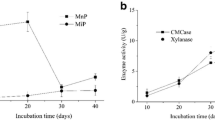Summary
The white-rot fungus Ganoderma australis selectively degrades lignin in the ecosystem “palo podrido”. Using conditions that simulate those of “palo podrido” in the laboratory, it was found that low nitrogen content and low O2 tension stimulate the productio of manganese peroxidase and lignin degradation, and depress cellulose degradation and cellulase production. The inverse is found at high nitrogen concentration and high O2 tension. This agrees with previous results indicating that low O2 tension and low nitrogen stimulate selective lignin degradation by this fungus.
Similar content being viewed by others
References
Agosín E, Blanchette RA, Silva H, Lapierre C, Cease KR, Ibach RE, Abad AR, Muga P (1990) Characterization of palo podrido, a natural process of delignification in wood. Appl Environ Microbiol 43:735–739
Crawford DL (1978) Lignocellulose decomposition by selected Streptomyces strains. Appl Environ Microbiol 35:1041–1045
Dill I, Kraepelin G (1986) Palo podrido: model for extensive delignification of wood by Ganoderma applanatum. Appl Environ Microbiol 52:1305–1312
Dill I, Kraepelin G (1988) Der Abbau von Lignin/Cellulose durch Weissfäule-Pilze: Einfluss spezifischer ökologischer Faktoren. Forum Mikrobiol 11/88:484–489
Drew SW, Kadam KL (1979) Lignin metabolism by Aspergillus fumigatus and white-rot fungi. Dev Ind Microbiol 20:153–161
Effland MJ (1977) Modified procedure to determine acid-insoluble lignin in wood and pulp. TAPPI 60:143–144
González A, Grinbergs J, Griva E (1986) Biological transformation of wood into feed for cattle — “palo podrido”. Zentralbl Mikrobiol 141:181–186
Kirk TK, Schultz E, Connors WJ, Lorenz LF, Zeikyus JG (1978) Influence of culture parameters on lignin metabolism by Phanerochaete chrysosporium. Arch Microbiol 117:277–285
Knoche W, Cruz-Coke E, Pacotet M (1929) Der “Palo podrido” auf Chiloé. Ein Beitrag zur Kenntnis der natürlichen Umwandlung des Holzes durch Pilze in ein Futtermiteel. Zentralbl Bakteriol Mikrobiol Parasitenkd Infektionskr Hyg Zweite Naturwiss Abt 79:427–431
Leatham GF, Kirk TK (1983) Regulation of ligninolytic activity by nutrient nitrogen in white-rot basidiomycetes. FEMS Microbiol Lett 16:65–67
Levi MP, Cowling EB (1969) Role of nitrogen in wood deterioration. VII. Physiological adaptation of wood-destroying and other fungi to substrates deficient in nitrogen. Phytopathology 59:460–468
Martínez AT, Barrasa JM, Prieto A, Blanco MN (1991) Fatty acid composition and taxonomic status of Ganoderma australis from southern Chile. Mycol Res 95:782–784
Nelson N (1944) A photometric adaptation of the Somogyi method for determination of glucose. J Biol Chem 153:375–380
Paszczynski A, Huynh V-B, Crawford R (1985) Enzymatic activities of an extracellular, manganese-dependent peroxidase from Phanerochaete chrysosporium. FEMS Microbiol Lett 29:37–41
Philippi F (1893) Die Pilze Chiles, soweit dieselben als Nahrungsmittel gebraucht werden. Hedwigia 32:115–118
Reid ID (1983) Effects of nitrogen sources on cellulose and synthetic lignin degradation by Phanerochaete chrysosporium. Appl Environ Microbiol 45:838–842
Reid ID, Seifert KA (1982) Effect of an atmosphere of oxygen on growth, respiration, and lignin degradation by white rot fungi. Can J Bot 60:252–2601
Tan LUL, Chan MK-H, Saddler JN (1984) A modification of the method for detecting protein in media containing lignocellulosic substrates. Biotechnol Lett 6:199–204
Zadrazil F, Grinbergs J, González A (1982) “Palo podrido” — decomposed wood used as feed. Eur J Microbiol Biotechnol 15:167–171
Author information
Authors and Affiliations
Additional information
Correspondence to: J. Eyzaguirre
Rights and permissions
About this article
Cite this article
Ríos, S., Eyzaguirre, J. Conditions for selective degradation of lignin by the fungus Ganoderma australis . Appl Microbiol Biotechnol 37, 667–669 (1992). https://doi.org/10.1007/BF00240746
Received:
Accepted:
Issue Date:
DOI: https://doi.org/10.1007/BF00240746




